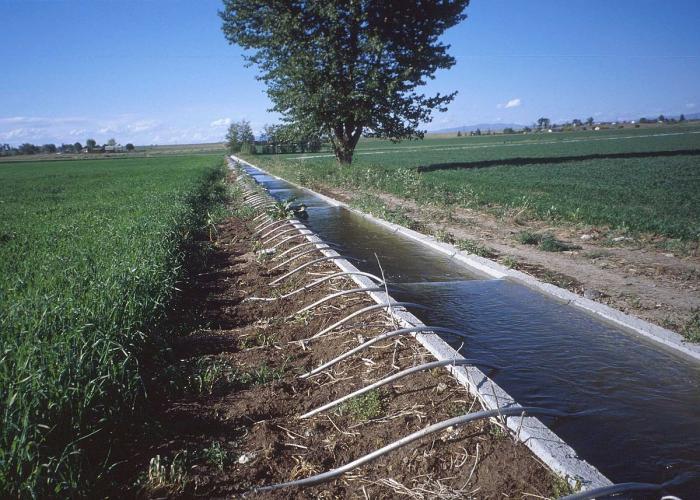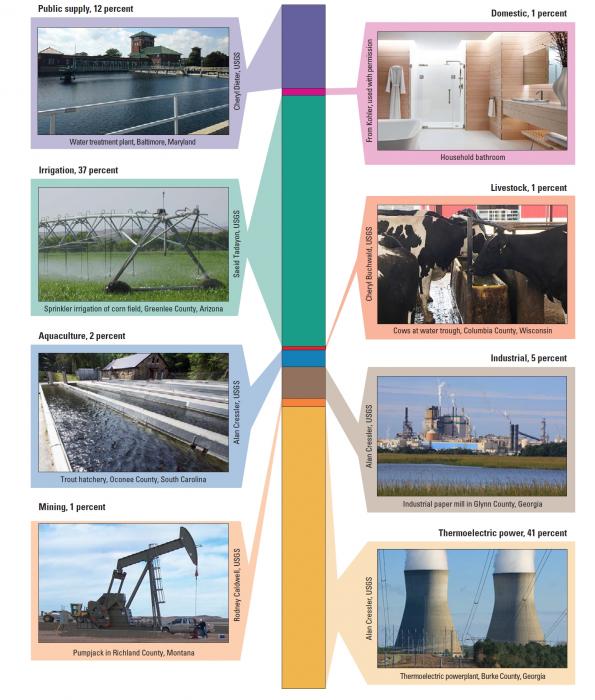6.2 Water conservation and protection technologies
Water use statistics
When water is extracted from the natural water cycle, where does it go?
Based on government statistics, a big part of it (~40%) is used for agricultural needs (e.g., irrigation for crops or livestock), around 47% is used for industrial needs (e.g., power generation, mining, etc.), and around 13% is going to public supply (e.g., domestic or commercial) (Figure 6.1). However, these numbers can vary with location. For example, in Minnesota, the majority of the water extracted is used for power generation, while in California, the dominating use is irrigation [USGS, 2015].

Although residential water consumption accounts for a smaller fraction of the whole, domestic water economy is considered an important factor in urban sustainability. The overall domestic water use is expected to grow as world population grows.
According to the U.S. Geological Survey 2015 water census, daily per capita domestic water use in the U.S. was 82 gallons per day, which was an improvement from 88 gallons per day estimated in 2010 census, and 101 gallons per day in 1995 census. This value represents the national average, and the actual local water use can vary broadly - for instance, from 35 gpd in Connecticut to 186 gpd in Idaho [USGS, 2015].
Typical US home water use accounting is:
- Showers - 19.5%
- Washers - 22.1%
- Toilets - 18%
- Dishwashers - 1.5%
- Baths - 2.7%
- Leaks - 8.8%
- Faucets - 23.9%
- Other - 3.4%
One can estimate how much water they use at home with some simple online calculators:
Water Conservation strategies
As the population grows, so does the stress on available water resources. Hence, there are a number of water conservation strategies, with some of the most intuitive approaches being:
- Limiting the consumption: Application of policies, economics, and technologies help regulate the demand. Policies may include restrictions and bans on certain types of water use, standards for fixtures and appliances, enforcement on recycling, etc. Economic measures, such as setting prices for water consumption, typically make people more diligent about their water-related activities. Technological advances may help use less water for the same function (water-economy washers, toilets, etc.)
- Reuse and recycling: Designing systems for reuse and recirculation of water in both domestic and industrial applications are involved in this approach. For example, treated wastewater can be used for irrigation; or water can be recycled in certain types of car wash systems.
- Elimination of losses: Regulation, metering, water-sensitive design, and smart technology are key factors contributing to this strategy. Leak identification systems, smart controllers for water use are some of such conservation technologies.
- Pollution prevention: Less pollution creates more opportunity for water reuse and conserves natural water reserves. Regulatory policies are introduced on water discharging facilities. Also, numerous technologies exist to treat the effluents from domestic and industrial facilities.
Sustainability goals and growing demands for clean water require new solutions in water conservation and use. There are technologies in place; however, many existing methods sometimes have low efficiency and are prone to water losses. Some innovative approaches are overviewed in this Guardian article: "The new water technologies that could save the planet."
The technologies mentioned in this article work out a number of issues, such as scalability, cost, and efficiency. In sustainable development, we want the systems to be affordable and compact, not using too many resources. That makes them easy to implement in both urban and rural settings.
US EPA introduced a set of strategic practices and policies to water promote water conservation. There are three levels of control, which are summarized in Table 6.1 below. Level 1 measures represent the most basic practices, Level 2 measures are intermediate-level controls, and Level 3 lists more advanced strategies for water conservation. When organizations design their water conservation programs, they may start at Level 1 and gradually proceed to Levels 2 and 3:
| Level 1 Measures | Level 2 Measures | Level 3 Measures |
|---|---|---|
| Universal metering | Water-use audits | Replacements and promotions |
| Water accounting and loss control | Retrofits | Reuse and recycling |
| Costing and pricing | Pressure management | Water-use regulation |
| Information and education | Landscape efficiency | Integrated resource management |
Complete the following reading assignment to learn what each of the above-listed measures involves.
Reading Assignment:
The following EPA document will help you to understand the key strategies and driving forces in water demand management and water conservation.
USEPA Water Conservation Plan Guidelines, EPA 1998, Appendix A: Water Conservation Measures, pp. 143-155.
While reading, look through the definitions of the terms listed in the above table and understand them. Implementation of these measures has triple leverage: economics, policy, and technology. As you read, particularly think about the role technologies may play in the effectiveness of these measures.
Check Your Understanding
This question is based on the above reading.
What kind of technologies would play a role in the implementation of the following measures of water conservation? Fill in your ideas in the blank, then click for answers.
Water reuse and recycling
Click for answer.
Efficient wastewater treatment technologies are crucial to enable multiple uses of water.
Water accounting and loss control
Click for answer.
Accurate water metering technologies, leak detection sensors, monitoring transmission system integrity
Landscape efficiency
Click for answer.
Lawn maintenance technologies, irrigation water sensing devices, soil improvement mulching
Retrofits
Click for answer.
Low-flow faucets and shower-heads, advanced plumbing materials

